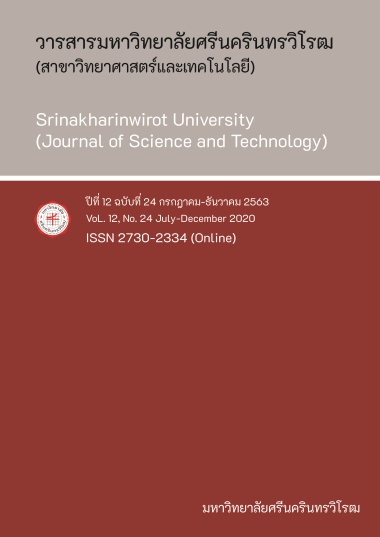ความสัมพันธ์ของดัชนีทางโภชนาการและการออกกำลังกายต่อความหนาแน่น มวลกระดูกในกลุ่มผู้หญิงไทยวัยหมดประจำเดือนซึ่งมีภาวะกระดูกบาง/กระดูกพรุน RELATIONSHIP OF NUTRITIONAL INDICES AND PHYSICAL ACTIVITY TO BONE MINERAL DENSITY IN OSTEOPENIA/OSTEOPOROSIS THAI POSTMENOPAUSAL WOMEN
Keywords:
Osteoporosis, Postmenopausal women, Bone mineral density, Nutritional indices and physical activityAbstract
Osteoporosis associates with lifestyle factors. To identify the environmental factors both of the dietary and activity patterns associated with osteoporosis in Thai postmenopausal women. The study population was derived from the data during 2007 to 2014. This cross-sectional study was performed in 331 Thai postmenopausal female volunteers, who attended the menopause clinic post-operation follow up clinic, Department of Obstetrics and Gynecology, Ramathibodi Hospital, Bangkok, for a physical check-up and bone mineral scan by dual-energy x-ray absorptiometry (DEXA). The prevalence of Thai postmenopausal women in this study were osteopenia (46.5%) and osteoporosis (28.4%) (classified by T-score bone mineral density; BMD at any sites). After adjustment for age and BMI, the data from questionnaire were analyzed. Weight, height, BMI, exercise, protein-sourced food, and biochemical parameters including calcium and phosphorus levels were associated with BMDs. The public health care system should concern in osteoporosis situation. The lifestyle factors, especially dietary factor, are associated with bone mineral density (BMD). This research recommended that exercise and dietary are very important factors for reducing the risk of osteoporosis. Further investigations with quantitative analysis of food and nutrient consumption and long-term follow-up should be investigated.
Downloads
References
[2] Prevention and management of osteoporosis. (2003). In Report of a WHO Study Group. World Health Organ Tech Rep Ser, 921, 1-164.
[3] Reginster, J.Y., & N. Burlet. (2006, February). Osteoporosis: a still increasing prevalence. Bone,
38(2), S4-S9.
[4] Cummings, S.R., & L.J. Melton. (2002, May). Epidemiology and outcomes of osteoporotic fractures. Lancet, 359(9319), 1761-1767.
[5] Pongchaiyakul, C., T. Songpattanasilp, & N. Taechakraichana. (2008, February). Burden of osteoporosis in Thailand. J Med Assoc Thai, 91(2), 261-267.
[6] Jarupanich, T. (2007, May). Prevalence and risk factors associated with osteoporosis in women attending menopause clinic at Hat Yai Regional Hospital. J Med Assoc Thai, 90(5), 865-869.
[7] Namwongprom, S., et al. (2011, June). Bone mineral density: correlation between the lumbar spine, proximal femur and Radius in northern Thai women. J Med Assoc Thai, 94(6), 725-731.
[8] Pongchaiyakul, C., et al. (2002, February). Bone mineral density in rural Thai adults living in Khon Kaen province. J Med Assoc Thai, 85(2), 235-244.
[9] Somboonporn, W., et al. (2001, October). Bone mineral density of lumbar spines and proximal femur in the normal northeastern Thai women. J Med Assoc Thai, 84(Suppl 2), S593-S598.
[10] Taechakraichana, N., et al. (1997, June). Bone loss in oophorectomized Thai women. J Med Assoc Thai, 80(6), 384-390.
[11] Nitzan-Kaluski, D., et al. (2003). Correlates of osteoporosis among Jewish and Arab women aged 45-74 in Israel: national women's health interview survey. J Gend Specif Med, 6(1), 17-23.
[12] Munaisinghe, R.L., V. Botea, & G.W. Edelson. (2002). Association among age, height, weight, and body mass index with discordant regional bone mineral density. J Clin Densitom, 5(4), 369-373.
[13] Asomaning, K., et al. (2006, November). The association between body mass index and osteoporosis in patients referred for a bone mineral density examination. J Womens Health (Larchmt), 15(9), 1028-1034.
[14] Ofluoglu, D., F. Unlu, & G. Akyuz. (2008, June). Relationship between arm span and height in postmenopausal osteoporotic women. Rheumatol Int, 28(8), 737-741.
[15] Penniston, K.L., & S.A. Tanumihardjo. (2006, February). The acute and chronic toxic effects of vitamin A. Am J Clin Nutr, 83(2), 191-201.
[16] Saarelainen, J., et al. (2011, May). Body fat distribution is associated with lumbar spine bone density independently of body weight in postmenopausal women. Maturitas, 69(1), 86-90.
[17] Uzunca, K., M. Birtane, & C. Zateri. (2008, January). Arm span-height difference is not an indicator of osteoporosis or associated vertebral deformity in postmenopausal women. Int J Clin Pract, 62(1), 157-159.
[18] Shin, A., et al. (2010). Dietary habit and bone mineral density in Korean postmenopausal women. Osteoporos Int, 21, 947-55.
[19] Polidoulis, I., J. Beyene, & A.M. Cheung. (2012, January). The effect of exercise on pQCT parameters of bone structure and strength in postmenopausal women-a systematic review and meta-analysis of randomized controlled trials. Osteoporos Int, 23(1), 39-51.
[20] Zhang, J., et al. (2006, January). Antioxidant intake and risk of osteoporotic hip fracture in Utah: an effect modified by smoking status. Am J Epidemiol, 163(1), 9-17.
[21] Misra, D., et al. (2011, January). Does dietary protein reduce hip fracture risk in elders? The Framingham Osteoporosis Study. Osteoporos Int, 22(1), 345-349.
[22] Kumar, A., et al. (2010, March). Impact of dietary intake, education, and physical activity on bone mineral density among North Indian women. J Bone Miner Metab, 28(2), 192-201.
[23] Sergi, G., et al. (2006, February). Role of visceral proteins in detecting malnutrition in the elderly. Eur J Clin Nutr, 60(2), 203-209.
[24] Baccaro, L.F., et al. (2015, March). The epidemiology and management of postmenopausal osteoporosis: a viewpoint from Brazil. Clin Interv Aging, 10, 583-591.
[25] Jackson, R.D., & W.J. Mysiw. (2014, November). Insights into the epidemiology of postmenopausal osteoporosis: the Women's Health Initiative. Semin Reprod Med, 32(6), 454-462.
[26] Dawson-Hughes, B., & H.A. Bischoff-Ferrari. (2007, December). Therapy of osteoporosis with calcium and vitamin D. J Bone Miner Res, 22(Suppl 2), 59-63.
[27] Nieves, J.W. (2005, May). Osteoporosis: the role of micronutrients. Am J Clin Nutr, 81(5), 1232S-1239S.
[28] Whiting, S.J., et al. (2002, October). Dietary protein, phosphorus and potassium are beneficial to bone mineral density in adult men consuming adequate dietary calcium. J Am Coll Nutr, 21(5), 402-409.
Downloads
Published
How to Cite
Issue
Section
License
Srinakharinwirot University Journal of Sciences and Technology is licensed Under a Creative Commons Attribution-NonCommercial-NoDerivs 4.0 International (CC-BY-NC-ND 4.0) License, Unless Otherwise Stated. Please Read Journal Policies Page for More Information on Open Access, Copyright and Permissions.



